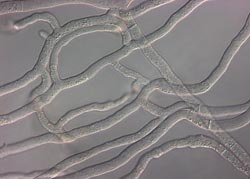Gap closed in the genetic map of kingdom fungi

Fruiting bodies of Pyronema confluens are shown. The diameter of the fungus' reproductive organs indicated here is half a millimeter. Credit: Stefanie Traeger<br>
Today, the genomes of more than 250 fungi have been sequenced. Among the basal filamentous ascomycetes – a group of ascomycetes that includes e.g. truffles and morels – only one representative has been analysed so far: the truffle Tuber melanosporum.
“With 125 million base pairs, the truffle genome is unusually big, yet it is coding for relatively few genes, namely some 7,500,” says Minou Nowrousian from the Department of General and Molecular Botany. “Until now, it was not clear whether this is typical of basal filamentous ascomycetes or whether it is caused by the truffle's 'atypical' lifestyle.”
Unlike other filamentous ascomycetes, the truffle does not develop reproductive organs – so-called fruiting bodies – above ground but rather below ground. Moreover, it only grows in symbiosis with plant roots (mycorrhiza). Pyronema, on the other hand, is a typical representative of its group.
Intermediary evolutionary stage
The genome of Pyronema confluens contains 50 million base pairs and some 13,000 genes; it is thus smaller than that of the truffle, and yet it contains more genes. These findings confirm the truffle's special position and provide new insights into the evolution of ascomycetes. “Pyronema confluens bears a stronger resemblance to higher ascomycetes than to the truffle,” concludes Minou Nowrousian. However, the scientists have also discovered differences to higher ascomycetes, for example in the DNA sequence containing the genetic blueprint for mating type genes. Mating type genes are the main regulators of sexual development and, in Pyronema confluens, they do not show the standardised structure that is typical for higher ascomycetes. “Pyronema confluens may represent an intermediary evolutionary stage in the evolution of mating type genes,” says the Bochum biologist.
Light-activated genes
One characteristic feature of the fungus under investigation is the fact that it produces fruiting bodies only in light. Fittingly, the researchers discovered genes in the Pyronema genome containing blueprints for photoreceptors for different wavelengths of visible light. The activity of some of those genes increased in light.
Pyronema – a typical representative of its systematic group
Project funding
The German Research Foundation (Deutsche Forschungsgemeinschaft, DFG) funded the project headed by PD Dr Minou Nowrousian (NO 407/4-1).
Bibliographic record
Traeger S, Altegoer F, Freitag M, Gabaldon T, Kempken F, Kumar F, Marcet-Houben M, Pöggeler S, Stajich JE, Nowrousian M (2013) The genome and development-dependent transcriptomes of Pyronema confluens: a window into fungal evolution. PLoS Genet 9(9): e1003820. doi:10.1371/journal.pgen.1003820
Further information
PD Dr Minou Nowrousian
Department of General and Molecular Botany
Faculty of Biology and Biotechnology at the Ruhr-Universität
44780 Bochum, Germany
phone: +49/234/32-24588
e-mail: minou.nowrousian@rub.de
Media Contact
More Information:
http://www.ruhr-uni-bochum.deAll latest news from the category: Life Sciences and Chemistry
Articles and reports from the Life Sciences and chemistry area deal with applied and basic research into modern biology, chemistry and human medicine.
Valuable information can be found on a range of life sciences fields including bacteriology, biochemistry, bionics, bioinformatics, biophysics, biotechnology, genetics, geobotany, human biology, marine biology, microbiology, molecular biology, cellular biology, zoology, bioinorganic chemistry, microchemistry and environmental chemistry.
Newest articles

“Nanostitches” enable lighter and tougher composite materials
In research that may lead to next-generation airplanes and spacecraft, MIT engineers used carbon nanotubes to prevent cracking in multilayered composites. To save on fuel and reduce aircraft emissions, engineers…

Trash to treasure
Researchers turn metal waste into catalyst for hydrogen. Scientists have found a way to transform metal waste into a highly efficient catalyst to make hydrogen from water, a discovery that…

Real-time detection of infectious disease viruses
… by searching for molecular fingerprinting. A research team consisting of Professor Kyoung-Duck Park and Taeyoung Moon and Huitae Joo, PhD candidates, from the Department of Physics at Pohang University…





















